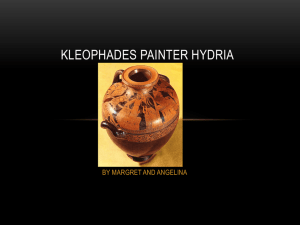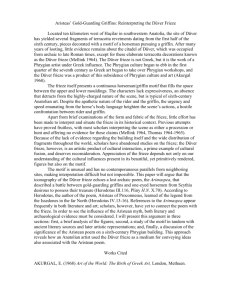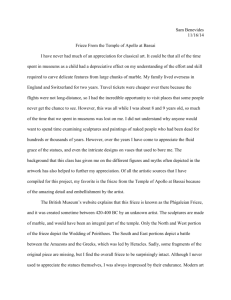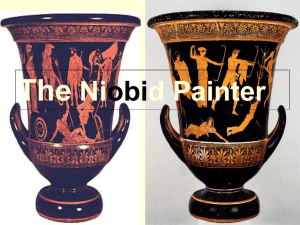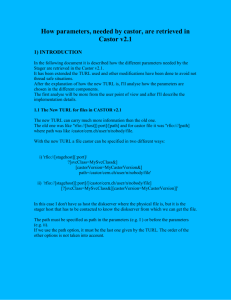Meidias Painter
advertisement
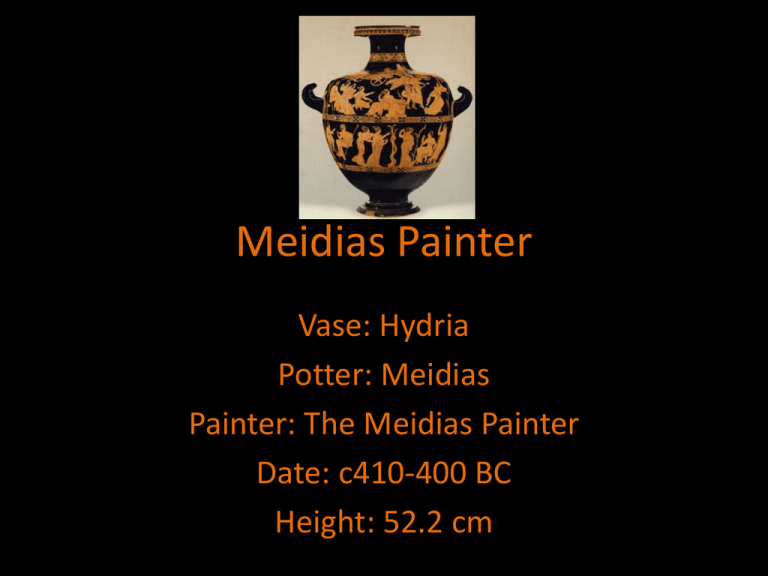
Meidias Painter Vase: Hydria Potter: Meidias Painter: The Meidias Painter Date: c410-400 BC Height: 52.2 cm Much like the other vases, the painter is not specifically known, however an inscription on a similar vase was found and so it became: THE MEIDIAS PAINTER. HYDRIA Used for carrying water, made most suitable with the two horizontal handles for carrying/lifting, and the handle on top for pouring. LOWER FRIEZE ACTION Heracles is chillin’ naked on a rock. We can tell it’s him because of: - Lion cloak - Club AND - He’s in the garden of Hesperides. This all relates to his twelve labours. Other figures in the scene are Lipara, Chyrsomethis, and Iolaus. Well, basically: Heracles, although granted extreme strength and courage, was cursed with fits of rage and temper by Hera (she had a few attachment issues). After a rage which saw him kill his children and perhaps, his wife, he had to pay his dues with twelve labours. (Meant to be ten but he got a bit sneaky). This is number 11. Castor Helera Zeus Aphrodite Eriphyle Aphrodite Polydeuces A C D F G E B Castor Polydeuces Helera Zeus Aphrodite Aphrodite Eriphyle The Abduction of the daughters of Leucippus by Castor and Polydeuces (the Dioscuri) in the sanctuary of Apollo. – The half-brothers Castor and Polydeuces were rivals of Idas and Lynceus, their cousins. Their rivalry would eventually lead to the death of all of them except Polydeuces (Zeus’ son). Before this, however, there was another episode. – Eriphyle was a priestess to Artemis and Helera was priestess to Athena. They were engaged to Idas and Lynceus, but Castor and Polydeuces fancied the girls. They carried them off while they were collecting flowers outside the sanctuary of Apollo, and married them, an act which started the quarrel between the boys. Aphrodite is just chillin’ beside her altar near her sanctuary. She is also up the top, in the centre of it all, as a much younger version of herself. Mannerist Painter Typical characteristics of Mannerist painters: - also known for going against the norm for the sake of showing talent, skill, intelligence. - Post-Renaissance mannerists played with composition and form as a means of showing personality (of painter – relates to humanist ideals.) Drapery – more important than you know The drapery is depicted as loose and flowing, in many different folds and with detail to show depth and weight. Creates elements of movement, the express of narrative and adds dramatic tension to the composition. (Incredibly large influence on Renaissance/NeoClassic painters because it depicted style, elegance and richness of quality). Women, incredibly important in depicting Athens as an ideal: They are shown as long and elegant. Posed, as if statues. Tugging at drapery – could display drama, tension, stylistic ideas, or perhaps they are itching to get it ooon. (Different historians have different ideas.. if you get what I mean). Let’s just say Helera looks a little keen to get to her.. destination. The forward position of her body aimed towards the horses depicts submission, she also is tugging at her drapery... This could have been done so Meidias could show off his awesome contrapposto skills. I don’t know what’s up with their faces. I think we need to team effort this one kids. Comparison? Faces have more definition and depiction of form. Achilles shows a flat form, lacks in tonal modelling (no glaze, perhaps?) and relies on line to show anatomy. Meidias is up there with his colour, shading, glazing and all. Red figure vase painting. Black background with figures painted onto the vase after, black relief used to show definition within form. Glaze known as ‘intentional-red’ helps highlight orange colour, show style, increase in ‘richness’ of the vase. Gold was added to accentuate colours and create more drama in the elaborate scenes. Due to the shape of the vase, the upper frieze is moved into different ‘levels’ of drama emphasised by a wavy groundline (it has sadly left the vase). This too, adds narrative effect, implying movement, shape and continuous action. Not typical of a frieze either. Lower frieze does move the figures to represent landscape and natural elements. A lot more level than upper though. No handles gettin’ in the way. LOWER FRIEZE Appears much more static, people are placed in positions, appearing as statues (emphasised by gold detailing) Elements of pyramidal composition creates a sense of symmetry or ‘flow’ within the painting. Idea of symmetry or coherent structure (accurate use of space) gives a consistent ideal and so therefore appears richer. UPPER FRIEZE Comparatively busy – depicting a scene of greater drama and tension. This is emphasised by the varied points of narrative focus – while the lower frieze has basic symmetry, the upper frieze has different points of contact between figures. Drama drama drama. Swirly patterns – bay leaves of Aphro’s sanctuary. And....? Meidias painter loved drama – an archetypal Mannerist who used the myths to create elaborate scenes that highly displayed beauty, even at the expense of composition.
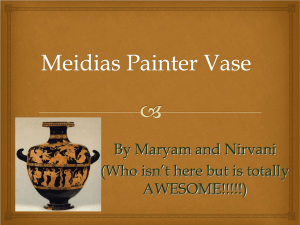
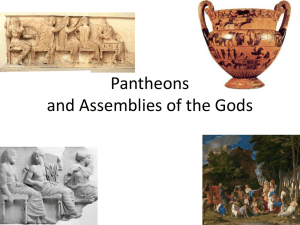
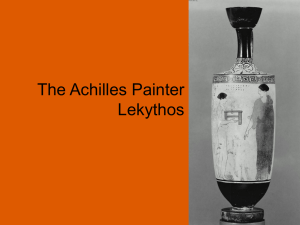
![The+Penthesileia+Painter+Pyxis[1]](http://s2.studylib.net/store/data/005444168_1-7d7fbf0e476d1696022d53030f2901d7-300x300.png)
